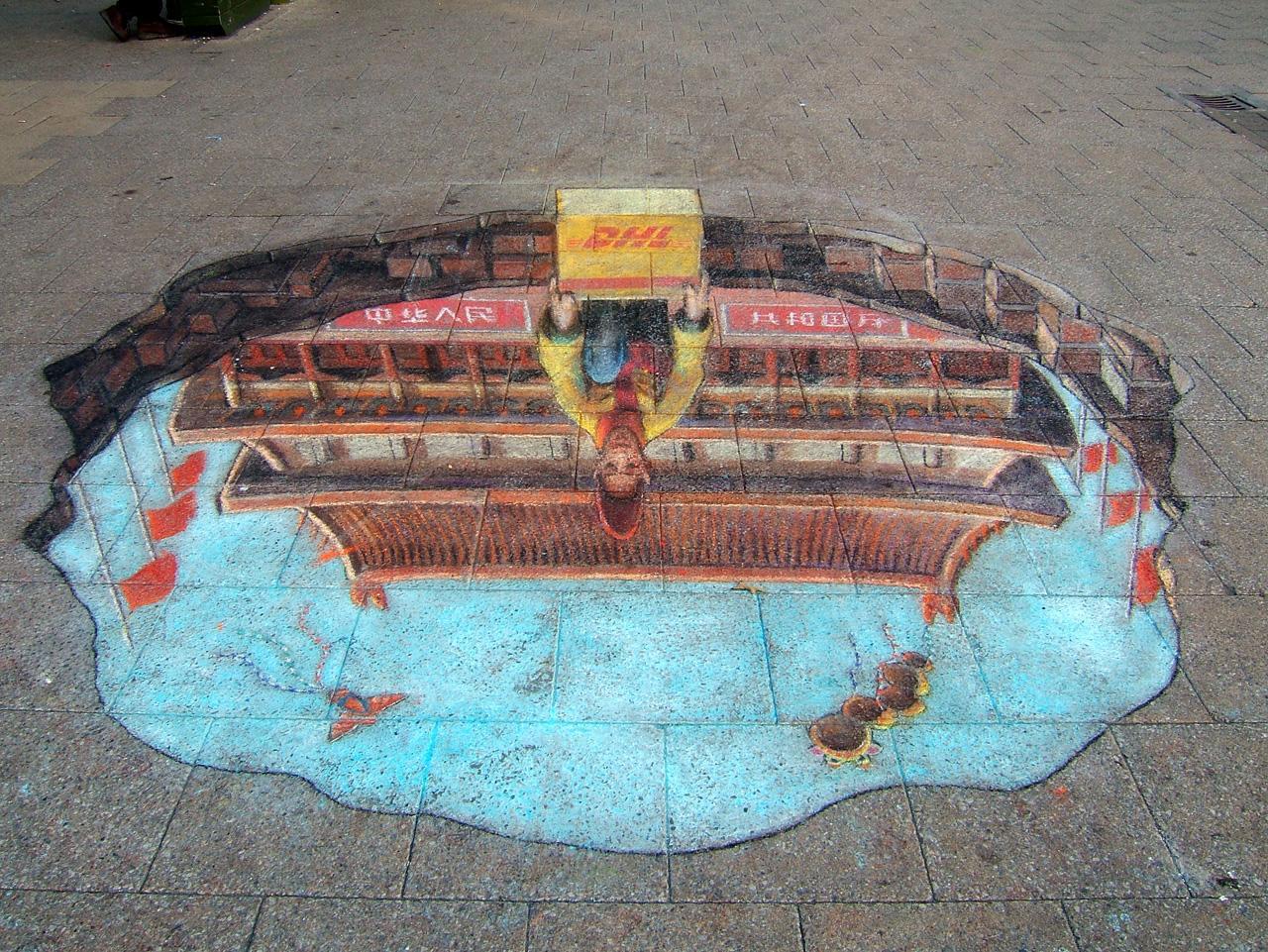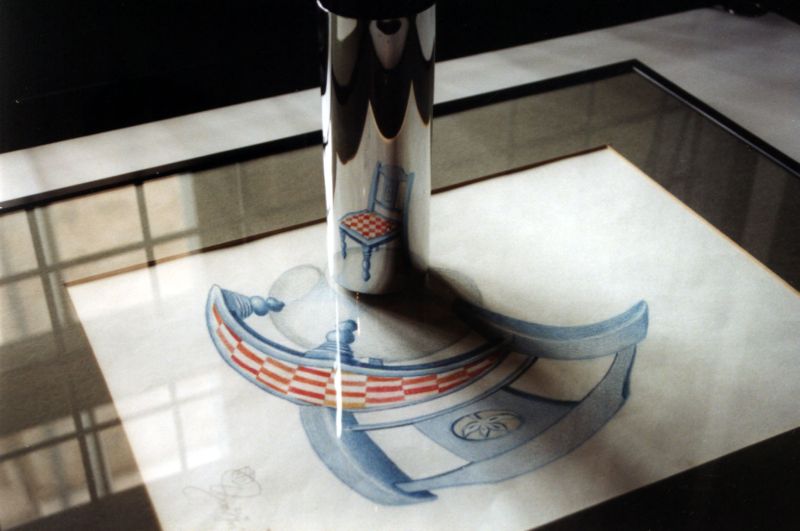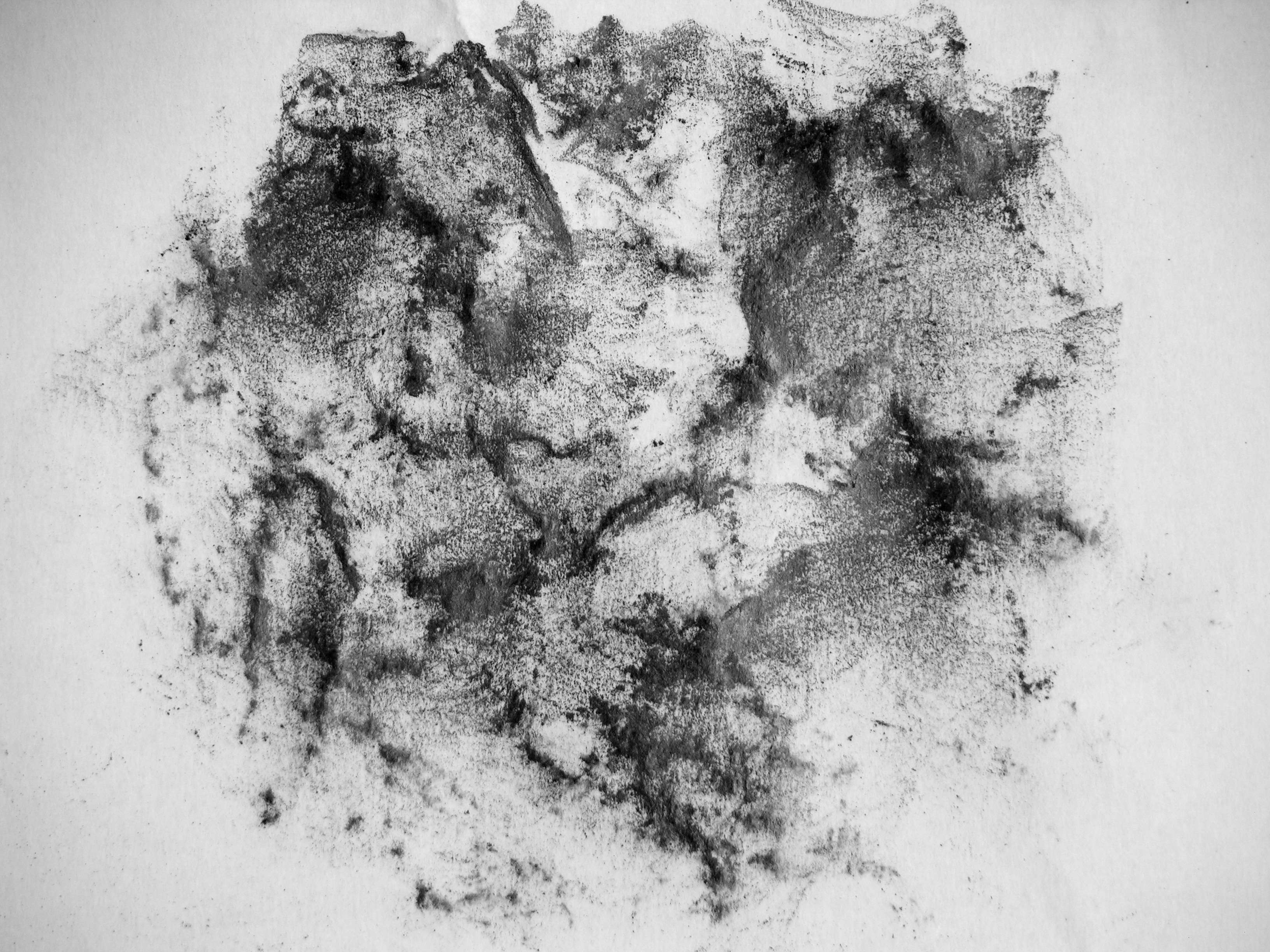|
Julian Beever
Julian Beever (born c. 1959) is a British sidewalk chalk artist who has been creating ''trompe-l'œil'' chalk drawings on pavement surfaces since the mid-1990s. He uses a projection technique called anamorphosis to create the illusion of three dimensions when viewed from the correct angle. He preserves his work in photographs, often positioning a person within the image as if they were interacting with the scene. Biography Beever grew up in Melton, Leicestershire, near the geographical centre of England. His talent in drawing had emerged by the time he was 5 years old; he liked school, especially his art classes(optical illusion). At the age of 18, he chose to study art, design, and psychology (as a last-minute substitute for English). He continued to excel in art, found design to be tedious, and discovered new insights into visual perception, depth perception, and the eye and brain in his psychology studies. After a gap year working as a laborer and carpet-layer's assista ... [...More Info...] [...Related Items...] OR: [Wikipedia] [Google] [Baidu] |
Anamorphosis
Anamorphosis is a distorted projection requiring the viewer to occupy a specific vantage point, use special devices, or both to view a recognizable image. It is used in painting, photography, sculpture and installation, toys, and film special effects. The word is derived from the Greek prefix ''ana-'', meaning "back" or "again", and the word ''morphe'', meaning "shape" or "form". Extreme anamorphosis has been used by artists to disguise caricatures, erotic and scatological scenes, and other furtive images from a casual spectator, while revealing an undistorted image to the knowledgeable viewer. Types of projection There are two main types of anamorphosis: ''perspective'' (oblique) and ''mirror'' (catoptric). More complex anamorphoses can be devised using distorted lenses, mirrors, or other optical transformations. An oblique anamorphism forms an affine transformation of the subject. Early examples of Perspective (graphical), perspectival anamorphosis date to the Renaissance ... [...More Info...] [...Related Items...] OR: [Wikipedia] [Google] [Baidu] |
Pastel
A pastel () is an art medium in a variety of forms including a stick, a square a pebble or a pan of color; though other forms are possible; they consist of powdered pigment and a binder. The pigments used in pastels are similar to those used to produce some other colored visual arts media, such as oil paints; the binder is of a neutral hue and low saturation. The color effect of pastels is closer to the natural dry pigments than that of any other process. Pastels have been used by artists since the Renaissance, and gained considerable popularity in the 18th century, when a number of notable artists made pastel their primary medium. An artwork made using pastels is called a pastel (or a pastel drawing or pastel painting). ''Pastel'' used as a verb means to produce an artwork with pastels; as an adjective it means pale in color. Pastel media Pastel sticks or crayons consist of powdered pigment combined with a binder. The exact composition and characteristics of an individual ... [...More Info...] [...Related Items...] OR: [Wikipedia] [Google] [Baidu] |
Perspective (graphical)
Linear or point-projection perspective (from la, perspicere 'to see through') is one of two types of 3D projection, graphical projection perspective in the graphic arts; the other is parallel projection. Linear perspective is an approximate representation, generally on a flat surface, of an image as it is seen by the eye. Perspective drawing is useful for representing a three-dimensional scene in a two-dimensional medium, like paper. The most characteristic features of linear perspective are that objects appear smaller as their distance from the observer increases, and that they are subject to ''foreshortening'', meaning that an object's dimensions along the line of sight appear shorter than its dimensions across the line of sight. All objects will recede to points in the distance, usually along the horizon line, but also above and below the horizon line depending on the view used. Italian Renaissance painters and architects including Masaccio, Paolo Uccello, Piero della Fran ... [...More Info...] [...Related Items...] OR: [Wikipedia] [Google] [Baidu] |
Julian Beever En Guayaquil
Julian may refer to: People * Julian (emperor) (331–363), Roman emperor from 361 to 363 * Julian (Rome), referring to the Roman gens Julia, with imperial dynasty offshoots * Saint Julian (other), several Christian saints * Julian (given name), people with the given name Julian * Julian (surname), people with the surname Julian * Julian (singer), Russian pop singer Places * Julian, California, a census-designated place in San Diego County * Julian, Kansas, an unincorporated community in Stanton County * Julian, Nebraska, a village in Nemaha County * Julian, North Carolina, a census-designated place in Guilford County * Julian, Pennsylvania, an unincorporated community and census-designated place in Centre County * Julian, West Virginia, an unincorporated community in Boone County Other uses * ''Julian'' (album), a 1976 album by Pepper Adams * ''Julian'' (novel), a 1964 novel by Gore Vidal about the emperor * Julian (geology), a substage of the Carnian stage of the ... [...More Info...] [...Related Items...] OR: [Wikipedia] [Google] [Baidu] |
Julian Beever By David Shankbone
Julian may refer to: People * Julian (emperor) (331–363), Roman emperor from 361 to 363 * Julian (Rome), referring to the Roman gens Julia, with imperial dynasty offshoots * Saint Julian (other), several Christian saints * Julian (given name), people with the given name Julian * Julian (surname), people with the surname Julian * Julian (singer), Russian pop singer Places * Julian, California, a census-designated place in San Diego County * Julian, Kansas, an unincorporated community in Stanton County * Julian, Nebraska, a village in Nemaha County * Julian, North Carolina, a census-designated place in Guilford County * Julian, Pennsylvania, an unincorporated community and census-designated place in Centre County * Julian, West Virginia, an unincorporated community in Boone County Other uses * ''Julian'' (album), a 1976 album by Pepper Adams * ''Julian'' (novel), a 1964 novel by Gore Vidal about the emperor * Julian (geology), a substage of the Carnian stage of the ... [...More Info...] [...Related Items...] OR: [Wikipedia] [Google] [Baidu] |
Manneken Pis
''Manneken Pis'' (; ) is a landmark bronze fountain sculpture in central Brussels, Belgium, depicting a puer mingens; a naked little boy urinating into the fountain's basin. Though its existence is attested as early as the 15th century, it was designed in its current form by the Brabantine sculptor Jérôme Duquesnoy the Elder and put in place in 1618 or 1619. ''Manneken Pis'' has been repeatedly stolen or damaged throughout its history. The current statue is a replica dating from 1965, with the original being kept in the Brussels City Museum. Nowadays, it is one of the best-known symbols of Brussels and Belgium, inspiring many imitations and similar statues. The figure is regularly dressed up and its wardrobe consists of around one thousand different costumes. Due to its self-derisive nature, it is also an example of '' belgitude'' ( French; ), as well as of folk humour ('' zwanze'') popular in Brussels. ''Manneken Pis'' is an approximate five minutes' walk from the Grand ... [...More Info...] [...Related Items...] OR: [Wikipedia] [Google] [Baidu] |
Mona Lisa
The ''Mona Lisa'' ( ; it, Gioconda or ; french: Joconde ) is a half-length portrait painting by Italian artist Leonardo da Vinci. Considered an archetypal masterpiece of the Italian Renaissance, it has been described as "the best known, the most visited, the most written about, the most sung about, the most parodied work of art in the world". The painting's novel qualities include the subject's enigmatic expression, the monumentality of the composition, the subtle modelling of forms, and the atmospheric illusionism. The painting has been definitively identified to depict Italian noblewoman Lisa Gherardini, the wife of Francesco del Giocondo. It is painted in oil on a white Lombardy poplar panel. Leonardo never gave the painting to the Giocondo family, and later it is believed he left it in his will to his favored apprentice Salaì. It had been believed to have been painted between 1503 and 1506; however, Leonardo may have continued working on it as late as 1517. It was ... [...More Info...] [...Related Items...] OR: [Wikipedia] [Google] [Baidu] |
Brussels, Belgium
Brussels (french: Bruxelles or ; nl, Brussel ), officially the Brussels-Capital Region (All text and all but one graphic show the English name as Brussels-Capital Region.) (french: link=no, Région de Bruxelles-Capitale; nl, link=no, Brussels Hoofdstedelijk Gewest), is a region of Belgium comprising 19 municipalities, including the City of Brussels, which is the capital of Belgium. The Brussels-Capital Region is located in the central portion of the country and is a part of both the French Community of Belgium and the Flemish Community, but is separate from the Flemish Region (within which it forms an enclave) and the Walloon Region. Brussels is the most densely populated region in Belgium, and although it has the highest GDP per capita, it has the lowest available income per household. The Brussels Region covers , a relatively small area compared to the two other regions, and has a population of over 1.2 million. The five times larger metropolitan area of Brusse ... [...More Info...] [...Related Items...] OR: [Wikipedia] [Google] [Baidu] |
Gratuity
A gratuity (often called a tip) is a sum of money customarily given by a customer to certain service sector workers such as hospitality for the service they have performed, in addition to the basic price of the service. Tips and their amount are a matter of social custom and etiquette, and the custom varies between countries and between settings. In some countries, it is customary to tip servers in bars and restaurants, taxi drivers, hair stylists and so on. However, in some places tipping is not expected and may be discouraged or considered insulting. The customary amount of a tip can be a specific range or a certain percentage of the bill based on the perceived quality of the service given. It is illegal to offer tips to some groups of workers, such as U.S. government workers and more widely police officers; the tips may be regarded as bribery. A fixed percentage service charge is sometimes added to bills in restaurants and similar establishments. Tipping may not be expecte ... [...More Info...] [...Related Items...] OR: [Wikipedia] [Google] [Baidu] |
Street Art
Street art is visual art created in public locations for public visibility. It has been associated with the terms "independent art", "post-graffiti", "neo-graffiti" and guerrilla art. Street art has evolved from the early forms of defiant graffiti into a more commercial form of art, as one of the main differences now lies with the messaging. Street art is often meant to provoke thought rather than rejection among the general audience through making its purpose more evident than that of graffiti. The issue of permission has also come at the heart of street art, as graffiti is usually done illegally, whereas street art can nowadays be the product of an agreement or even sometimes a commission. However, it remains different from traditional art exposed in public spaces by its explicit use of said space in the conception phase. Background Street art is a form of artwork that is displayed in public on surrounding buildings, on streets, trains and other publicly viewed surfaces. Many ... [...More Info...] [...Related Items...] OR: [Wikipedia] [Google] [Baidu] |
Puppet Theater
A puppet is an object, often resembling a human, animal or mythical figure, that is animated or manipulated by a person called a puppeteer. The puppeteer uses movements of their hands, arms, or control devices such as rods or strings to move the body, head, limbs, and in some cases the mouth and eyes of the puppet. The puppeteer often speaks in the voice of the character of the puppet, and then synchronizes the movements of the puppet's mouth with this spoken part. The actions, gestures and spoken parts acted out by the puppeteer with the puppet are typically used in storytelling. Puppetry is a very ancient form of theatre which dates back to the 5th century BC in Ancient Greece. There are many different varieties of puppets, and they are made from a wide range of materials, depending on their form and intended use. They range from very simple in construction and operation to very complex. Two simple types of puppets are the finger puppet, which is a tiny puppet that fits ... [...More Info...] [...Related Items...] OR: [Wikipedia] [Google] [Baidu] |
Punch And Judy
Punch and Judy is a traditional puppet show featuring Mr. Punch and his wife Judy. The performance consists of a sequence of short scenes, each depicting an interaction between two characters, most typically Mr. Punch and one other character who usually falls victim to Punch's slapstick. ''The Daily Telegraph'' called Punch and Judy "a staple of the British seaside scene". The various episodes of Punch comedy—often provoking shocked laughter—are dominated by the clowning of Mr. Punch. The show is performed by a single puppeteer inside the booth, known since Victorian times as a "professor" or "punchman", and assisted sometimes by a "bottler" who corrals the audience outside the booth, introduces the performance, and collects the money ("the bottle"). The bottler might also play accompanying music or sound effects on a drum or guitar, and engage in back chat with the puppets, sometimes repeating lines that may have been difficult for the audience to understand. In Victorian ... [...More Info...] [...Related Items...] OR: [Wikipedia] [Google] [Baidu] |







.jpg)